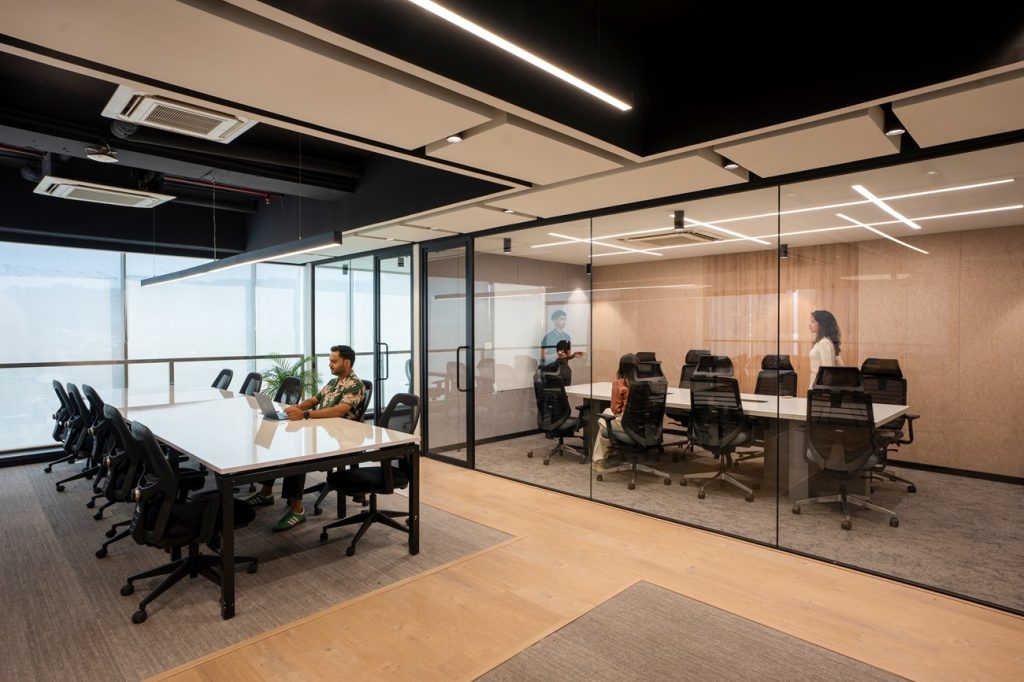The shift towards remote work has reshaped the corporate landscape, making hybrid work models a standard practice. This evolution calls for a reimagination of office design to support both in-office and remote employees. A well-crafted hybrid workplace is about enhancing functionality, productivity, and employee well-being.

At Studio AsA, we specialize in designing workplaces that embrace flexibility while encouraging collaboration. Let’s explore how modern office designs can cater to hybrid work models effectively.
Understanding Hybrid Work Models
Hybrid work models combine the flexibility of remote work with the structure of in-office operations. Employees split their time between working from home and collaborating in-office. To accommodate this approach, office interior designs must be versatile and support different work styles and tasks.
Benefits of Hybrid Work Models:
- Flexibility: Employees can work from environments that best suit their productivity.
- Work-Life Balance: Greater control over schedules helps reduce burnout and improve well-being.
- Cost Efficiency: Businesses can optimize office real estate and reduce overhead costs.
Key Elements of Hybrid Office Design
-
Versatile Workstations
Traditional cubicles are giving way to adaptable office designs that can be reconfigured as needed. Key solutions include:
- Hot Desks: Unassigned desks for employees who come in periodically.
- Collaboration Zones: Large tables and lounge seating for team interactions.
- Quiet Zones: Dedicated spaces for focused, individual work.
-
Seamless Technology Integration
Hybrid office designs must be equipped with technology that supports both in-person and remote collaboration. Essential features include:
- High-Speed Internet: Ensures seamless connectivity for virtual meetings.
- Video Conferencing Tools: High-quality cameras, microphones, and screens enhance communication.
- Cloud-Based Systems: Enable easy access to files and collaboration tools from any location.
-
Wellness-Oriented Spaces
Employee well-being should be a priority in hybrid office design. Consider incorporating:
- Breakout Rooms: For relaxation and informal discussions.
- Fitness Areas: Small gyms or yoga spaces encourage physical activity.
- Green Spaces: Indoor plants and access to natural light enhance mood and productivity.
-
Ergonomic Furniture
A comfortable work environment improves focus and reduces physical strain. Key investments include:
- Adjustable Desks: Allow employees to switch between sitting and standing.
- Supportive Chairs: Provide proper back and neck support.
- Monitor Stands: Ensure screens are at eye level, reducing strain.
-
Sustainable Design
Sustainability is a necessity. Offices should prioritize:
- Energy-Efficient Lighting: Utilize LED lights and natural daylight where possible.
- Recycled Materials: Opt for furniture and decor made from sustainable materials.
- Waste Management Systems: Implement recycling and composting programs.
Designing Effective Home Workspaces
With remote work becoming a permanent fixture, employees need well-equipped home offices. Encourage best practices such as:
- Dedicated Workspaces: A specific area for work enhances concentration.
- Ergonomic Setup: A comfortable chair, desk, and proper lighting minimize strain.
- Distraction Management: Noise-cancelling headphones and a clutter-free environment help maintain focus.
Fostering Collaboration in Hybrid Work Environments
Maintaining strong team dynamics in a hybrid model can be challenging. Offices must facilitate collaboration both in-person and virtually.
In-Office Collaboration
- Open Plan Areas: Encourage spontaneous discussions and brainstorming sessions.
- Meeting Rooms: Equipped with interactive tools like whiteboards and smart screens.
- Casual Gathering Spots: Lounges and kitchen areas foster informal networking.
Virtual Collaboration
- Reliable Virtual Meeting Platforms: Ensure seamless remote communication.
- Online Project Management Tools: Platforms like Slack, Trello, and Asana streamline tasks.
- Regular Check-Ins: Frequent virtual meetings maintain engagement and connection.
The Future of Hybrid Workplaces
The future of work is adaptable. Offices must continuously evolve to meet the changing needs of employees.
- Employee Feedback: Regular input ensures workplaces remain effective and engaging.
- Flexible Design: Spaces should be easily modified as business needs shift.
- Innovation in Workplace Solutions: Integrating emerging technologies enhances the hybrid experience.
Studio AsA: Your Partner in Hybrid Office Design
At Studio AsA, we create the best office designs that seamlessly support hybrid work models. Our designs emphasize functionality, collaboration, and well-being, ensuring businesses thrive in a dynamic work environment.
Ready to future-proof your workspace? Contact Studio AsA today to design office interiors that adapts to your evolving needs.


